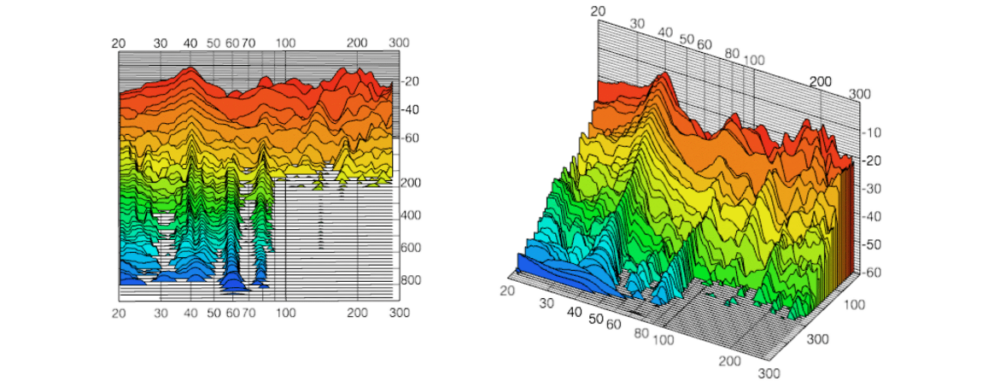

Use the same principle to decide whether to dampen the front wall behind the monitors. If it's greater then allow for the idea that the returning energy could be beneficial and won't interfere with the direct sound, so you might try some diffusion, or only partial absorption. If the distance is less than 20 feet, dampen the back wall. Then when you have established your mix position, and used mirrors to dampen early reflections (including a cloud for ceiling reflections) check out the total distance from the speakers to the back wall and then back to your listening position. You can move them according to how much you want your low end enhanced. Try to keep your speakers at least a foot or two from the front wall (some monitors, like ADAMs, actually specify a distance). Try to set it all up lengthwise and at least start with a monitoring position that is 38% of the room's length distance from the front wall.


Place your speakers so that they are not equidistant from any wall, ceiling or floor. It's important as a first step to clear out the boxy sounding mud and reduce close first reflections. His reasoning is interesting and in my experience is true.Īs a general approach, I'd say you'll never be able to deal with the ultra low modes, and actually the super high end really doesn't matter as much as you might think. One acoustician, Steven Klein, makes the case that a bright room will generate bright mixes, a dark room dark mixes, a dry room dry mixes, etc. Keep in mind that it's not scripture that a bright room generates a dark or muddy mix. I actually end up getting bass heavy and muddy mixes outside the studio, so the speakers might be bright.

diffusion is not something I can take into account right now - I will have to use whatever I have - I just don't know where to start. Things like thickness of treatment and absorption vs.
#Setting up fuzzmeasure free
I think I'm pretty stuck as to which wall to place the desk on, but I'm pretty free when it comes to depth.Īny help will be beneficial and much welcome.Īnd, at least to begin with, I'm just looking for basic guidelines. When do I start to adjust the EQ on the speakers? Last resort? How do I decide if my speakers are the right size? Does it matter? What is the best way to measure and what am I looking for? Do I place my treatment before I measure? Do I start with speaker placement or listening position? Should I empty the room and start out only with the speakers? Adjusting speaker EQ (I have low, mid, high pots on the back) Choosing treatment type (can of worms? don' open it)Ħ. Speaker size for the room (are my 8" too big?)Ĥ. A design I must revisit.Īnywho, what I'm asking is where do I begin finding a good solution?Īs far as I can understand there are these points to consider/follow.ģ. I also build some bass traps in the corners covered with plywood. I put my speakers (8" KS Digital C-88) on stands behind the desk and I placed my DIY acoustic panels (2" rigid rock wool spaced 2" from the wall) on the 1st reflective points using a mirror. (I know)Įarlier I had my desk placed 38% of the total length back from the short wall under the part of the ceiling where the slant begins, as the back wall is kinda handicapped by a iso-booth sticking out from the other room. I don't have the exact numbers on me, (I can measure next time I'm down there), but it's approximately 3x4,5 meters - and the ceiling is as low as 2.10 meters with a slant at one end going down to 1.90. And I'm not looking for the 'correct answer' for my room, as there probably is a 100 different ways to do this, but where do I begin to narrow things down?įirst let me just explain my room. I know there are a lot of myths out there and no hard and fast rules - but are there any guides as to where to actually begin? Cause I really don't have any clue. And, obviously, my mixes don't translate at all. I set up my studio a few years back, and have over time done the acoustic treatment and stuff - but I recently painted a wall and after painting I kinda just set up my station after what worked best for the space I needed, not the sound. So, I think it's time for me to go deeper into the actual layout/design of my control room - and I don't really know where to start.


 0 kommentar(er)
0 kommentar(er)
